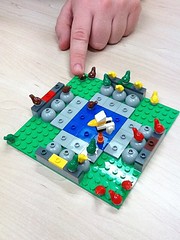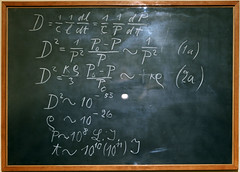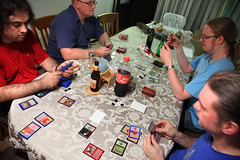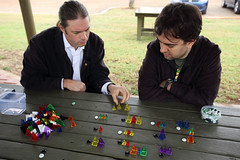

| Archive Blog Cast Forum RSS Books! Poll Results About Search Fan Art Podcast More Stuff Random |
|
Classic comic reruns every day
|
1 {photo of some of the Lewis Chessmen}
1 Caption: Designing Games
|
First (1) | Previous (3204) | Next (3206) || Latest Rerun (2818) |
Latest New (5380) First 5 | Previous 5 | Next 5 | Latest 5 Annotations theme: First | Previous | Next | Latest || First 5 | Previous 5 | Next 5 | Latest 5 This strip's permanent URL: http://www.irregularwebcomic.net/3205.html
Annotations off: turn on
Annotations on: turn off
|
My friends and I like to design games. Specifically, board and card games[1]. Our group at work uses our lunch break to, among other things, play games, talk about games, design games, and test out our newly designed games.
 The LEGO game Frog Rush. |
For the most part, the games we play are modern European-designed games. Examples include The Settlers of Catan, Ticket to Ride, Puerto Rico, Ra, Tigris & Euphrates, Formula Dé, Pandemic, Power Grid, Dominion, 7 Wonders, and so on. We keep an eye out on new game releases and buy and try new ones that look interesting.
The big exception to the European board games we play is the US-designed card game Magic: the Gathering. For anyone who doesn't know, this is a card game that evolves over time as new sets of cards are released, which contain new rules that increase the pool of possibilities and interactions within the game. Furthermore, it's an excellent case study of game design in action, assisted by the fact that Mark Rosewater, who has been a Magic designer since 1996 and the head of Magic design since 2003, writes a weekly article about the design of Magic and elements of game design in general. For anyone interested in game design, these articles are a must-read.
The thing about game design is that it has evolved over the years. Early games tended to be almost haphazard in their designs, followed by a period in which new games were mostly retreads of the "classics". This is why we have a legacy of games in which players roll dice and then move a piece on a board. Cluedo, for example, has a wholly unnecessary dice-roll-and-move mechanic that really adds nothing to the core elements of game but random frustration. This mechanic was not in the original design, but was added at the publisher's request based on the idea that people might be stumped as to what to do if there was no dice rolling involved. This notion has alas even carried through to the present day with some game manufacturers. For example, the LEGO Games line of board games, all of which have a roll-then-move dice mechanic, despite some of them being almost trivially tweakable to be more interesting and fun games by removing the dice roll element.
 Encaustic Virgin, from Saint Catherine's Monastery, Mount Sinai. |
European artists in the Medieval and earlier periods had a much less expansive repertoire of painting styles than artists today. Much of it was Christian iconography, executed in styles that to untrained modern eyes look virtually indistinguishable. Then along came artists such as Sandro Botticelli, who developed a visually different style and subject matter. This development of new styles blossomed in the Renaissance when artists began using rules of perspective to produce the most realistic portrayals of their subject matter to that time. This trend of realism gradually gave way to more impressionistic styles, which in turn paved the way for abstraction and the plethora of recognisable artistic styles we see today. The artists who pioneered the new styles are the ones we remember: Botticelli, Rembrandt, Monet, Picasso, Dali. You don't need to like what they've done to appreciate that they have expanded the artistic repertoire of our culture, and provided building blocks for future forms of art which we have not yet imagined, but which may be germinating inside some artist's head as we speak.
It is the same way with game design, although its history is so much smaller that we are no doubt still within the early stages of its development. We can appreciate early work in the field, but at the same time we can see that the available styles then were limited and, honestly, relatively crude compared to the wide array of game design tools and knowledge we have today. Today a game designer has a much better idea of what makes an engaging and fun game than designers of yore. This is why the field of games is active and growing, with new games being published every year. Some will turn out to be true inspired masterpieces, and will retain a following of players for many years to come. These are the works of game design's Botticellis and Rembrandts and Picassos. Others are experiments that add to the collective culture of game design and allow others to follow and produce more original and intriguing games.
So to really experience games, it is not enough to sit back with your copy of Monopoly or Trivial Pursuit or Risk and simply pull that out every time you want to play a game. You'd be missing out on the action, the fun, and, to put it bluntly, better games. But the heart of this article is not simply to criticise old games and implore readers to try new games, but to illustrate what principles modern game designers use to come up with a game that is more likely to be fun to play than the games of yore. I'm not an expert in game design, but I've played enough, designed enough, and participated in enough play-testing of games designed by friends (and professional game designers) to have some idea of what is important.
So here follows some of the wisdom I've picked up about game design. These are not hard and fast rules, by any means. If you know what you're doing you can break any one of them and get away with it. But I would call them very good ideas to think about when designing a game.
 Last Miracle and the Death of St Zenobius by Sandro Botticelli. |
2. Don't make it easy for the leader to increase their lead. At some point in the game, some player will be ahead and the other players will be trying to catch up. If the game is structured such that a player in the lead finds it significantly easier to maintain and build their lead than it is for the other players to catch up, then the end-game acquires a scent of inevitability. If you're losing, you may as well just give up rather than go through the pain of playing another ten turns with no realistic hope at all. That's no fun. In our group, we call rules that allow the leader to easily increase their lead a "win more" mechanic. A "win more" mechanic is not a good thing for a game to have. This leads straight into...
3. Make catching up to the leader relatively easy. The converse of a "win more" mechanic is a "catch up" mechanic. This is a rule that makes it relatively easier for a losing player to catch up than for the winning player to increase their lead. It shouldn't be trivial or even likely for players to catch up—they should have to work for it—but they should have a decent, realistic chance. You should still be better off being in the lead (otherwise players won't want to lead and the game becomes chaotic), but you have to be vigilant to guard that lead, rather than coasting to victory over the despondent bodies of your friends who gave up ten turns ago. Some sort of "catch up" mechanic is often a good thing in a game design. It keeps everyone—the leader and the trailers—interested and on their toes right to the end.
 A king. Avoid making these. |
A more general principle here is that Alice's decisions should affect her own fortunes in the game more than they affect other people's fortunes. It's simply more fun for everybody involved if what you're doing in the game is making your own position stronger, rather than trampling on whichever other player you feel most like victimising.
5. Give players important decisions to make. Some games have essentially no decision making requirements at all. You roll the dice, move your piece, do what the board tells you to do, and that's your turn. Such games quickly become dull[3]. If you need to make decisions, then the outcome of the game is (at last partly) in your hands rather than down to pure luck. This makes the game more engaging. Once you've given players decisions to make, the next step is...
6. Give players difficult decisions to make. In fact, I'll state this much more strongly: Make it effectively impossible to calculate what the best decision is. This may sound counter-intuitive, but a game tends to be more fun if you can't figure out what you should do on your turn. This is perhaps best illustrated by example:
Imagine a game in which you have perfect information; in other words, for every possible move you can make, you can examine the board state and work out some sort of score that indicates your position relative to all the other players. If you place a pyramid here, then your score will be 35 points, but if you place a temple there, your score will be 33 points, on the other hand if you place a statue hither, your score will be 38 points but Alice's score will increase by 4 points as well... But hmmm, if you place an obelisk thither your score will be 32 points but Bob's score will be reduced by 7...
 Deciding what to do on your move should not involve this. |
And it only took you 15 minutes of staring at the board and doing mental arithmetic to do so, while everyone else is twiddling their thumbs. Now it's Alice's turn, and she starts calculating what her best possible move is...
You see the problem here. This is such an easy trap to fall into as a game designer that it appears in dozens of published games and has a common label in the gaming world: analysis paralysis. Everybody is so busy analysing the game to figure out their best possible move that the game slows to a crawl.
There are two possible solutions to analysis paralysis. One is to make the analysis so easy that it only takes a few seconds. But the problem then is that every player can easily make the optimal move at every stage of the game, making the game predictable and trivial - essentially not worth playing. This is the fate of games like noughts and crosses once you grow old enough to look ahead a few moves.
The second solution is to make the analysis so hard that it is effectively impossible for a human to figure out what the best move is (in anything under a few hours). If this is the case, your best course of action as a player is to make a decision based partly on gut instinct and a heuristic understanding of the game than on an exhaustive mathematical analysis. And players tend to make such decisions much faster than if they are calculating every last possibility. To make analysing game moves difficult, there are three approaches:
 A game with randomness: Magic: the Gathering. |
Most games choose the third approach: randomness. This may not be obvious at first glance, because a lot of modern games don't use dice - the traditional and expected source of randomness in games. However, many modern games use decks of cards, or a pool of tiles that are drawn or turned over at specific points in the game. Some use even more subtle sources of randomness. It's good to disguise it a little bit, because players like the feeling that they are in control, rather than blind fate.
Randomness adds an important element of uncertainty to games. After all, if everyone knew for sure who was going to win, there'd be little point in playing. With a bit of randomness, more skilful and more thoughtful players are still more likely to win, but it's not a sure thing. Less skilful players need to believe they have a chance of winning too. The interplay between meaningful decisions and a bit of uncertainty adds drama and excitement to a game, which is a large part of what makes it fun. The above-mentioned Mark Rosewater wrote a whole article about the importance of randomness in game design, and how to use it effectively.
Another manifestation of randomness that might not be obvious is hidden information. This is where only certain players in the game know certain information. Between all the four players in a game of bridge, the positions of all of the cards are known - what's important is that each individual player doesn't know what the other players know. In bridge it's pretty clear that the hidden information is generated by randomness when the cards are dealt. In games such as Diplomacy, the hidden information comes from simultaneous play - each player has to make a decision at the same time as the other players. In one sense there is no randomness, because all of the game play is determined by the decisions of the players, but at any time you don't know what the other players are doing and have to make your decisions blind to that information. From the point of view of the information available to you when you have to make your decisions, the other players' moves are effectively somewhat random. The fun game Robo Rally also relies on simultaneous play for much of its complexity, though there is also some real randomness thrown in as well.
This has been a long point, but it's related to the next one...
 A game with something to think about at all times: Zendo. |
On the other hand, if the state of the game changes drastically every time someone makes a move, there might be no point thinking about your move until it's actually your turn, because any previous thinking doesn't apply any more. This slows down everyone's moves, and makes it so that in between moves you essentially have nothing to do but get frustrated about good moves you could have made, if only the last player's move hadn't mucked it up for you.
In short, the game state should change a relatively small amount with each move, rather than chaotically after every move. You end up getting more moves in a shorter period of time this way, which is good for the interactivity and interest levels of everyone involved. And the fact that you're getting lots of moves in means the game can evolve over time, even if the change with any single move is small.
That ends my list of important things to consider when designing a game. You may not be inspired to design games, but hopefully I've inspired you to think a bit about what makes games fun, what makes many of the old "classic" games not so much fun, and perhaps to try some modern games to find something new that you might enjoy. The website BoardGameGeek is a great resource, and has a list of games which you can sort by ranking, based on the ratings of thousands of game players. Even if you think board games are not your thing, try a few in the top 20, and you may be pleasantly surprised at just how much fun you can get out of spending an hour or so with friends around a well-designed board game.
[2] A boring name that totally misses out on the great pun on "Ludo".
[3] Unless there's money involved. Many gambling games are essentially decision-free, and it's amazing how intense they can get, for certain types of people.
|
LEGO® is a registered trademark of the LEGO Group of companies,
which does not sponsor, authorise, or endorse this site. This material is presented in accordance with the LEGO® Fair Play Guidelines. |